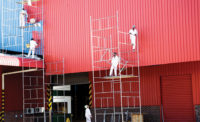I see it all the time. For whatever reason, OSHA is at the door unannounced – to start a random inspection, investigate a safety complaint, to begin an investigation – and everyone from the plant manager to the safety department starts to sweat. Department phones are ringing, radio chatter escalates, the entire site is ablaze with scurrying activity to sweep, clean, hide, find, review, warn, and inform employees to “do it right, the OSHA inspector is here.”
If that describes you and your site, what do you think are your odds of coming out of this “clean?” With years of experience working to help employers either avoid this scene or to recover from this scene, I would say it is not good.
What if you had the written plans, the training records, PPE, the audiograms, the guards in place, LOTO procedures for your specific equipment, an accountability program, and employees who could intelligently describe their roles and tasks, already in place? What if the inspector arrived on “just another day” where people were doing what they were supposed to be doing and doing it right? You might ask, “How does that happen and how would I know?”
If you are prepared for an OSHA visit, you likely also have a better safety program and culture. You likely have trained employees, plans in place, emergency drills up to date, and records ready for review. The title of this article is a bit misleading because if you are ready for an OSHA visit, you likely already have a good safety record and program. You likely have engaged employees who help you find and correct hazards to ensure you have a safe workplace.
To be ready, you should at least conduct and track your own internal inspections and audits. These tasks will identify shortfalls while also identifying what is good.
An inspection is a snapshot of what is happening right now with your employees – to evaluate what is good and what may need to be addressed. An inspection looks for hazards as unsafe conditions and unsafe practices, observing tasks for correctness, ensuring first aid kit contents are not expired, checking that PPE is being worn and used properly. In other words, an inspection shows what is currently being done by employees.
An audit determines what regulatory requirements apply to you, and, for starters, whether you have them. It is a checklist to review required programs, ensure they exist, and then determine if what you are doing matches what the programs require. Examples include locating and ensuring you have all of the written plans in place, noting when you conducted your last emergency drill, checking if you have a response team to meet the 5-minute time requirement, checking to see if you have first aid kits and where they are located, ensuring you are conducting forklift pre-inspections. In other words, an audit shows you what should be done and if you are on track.
Conducting inspections and audits
Who can conduct an internal inspection? Anyone or any team, at any level of the organization can do an inspection if that person or team has knowledge (training) on what to look for. Participants can inspect their own work areas or schedule a walk through other work areas as a fresh set of eyes. They should know that a hazard can be an unsafe action or practice as much as (if not more than) an unsafe condition. Conditions generally don’t exist unless a practice or action creates it. So, teams look for both conditions and practices to make their workplace safer.
An audit is an administrative checklist of required/regulated programs – anyone can conduct an audit because all the person is doing is completing the checklist. Generally, it should be conducted by someone outside of the department being audited. The auditor does not have to know how to do the tasks; the auditor just needs to identify that the programs exist, where they are kept, and that they are current. For example, does the location have emergency evacuation drills? Is there a procedure and employee training on evacuating the premises? When was the last training conducted? When was the last drill conducted (should be at least annually or when the plan changes)?
Documentation
Inspection and audit findings should be documented so if something needs addressing, it gets assigned, followed up, and completed. The document can be a tracker, a spreadsheet, an e-file and should become part of a daily cadence until the items are complete.
Conclusion
Conducting your own inspections and audits will help prepare you for that OSHA visit and increase your employee engagement, which will enhance your safety culture. The inspection eliminates hazards and engages your employees; the audit aids in compliance. Having both in place and in practice will reduce your hazards and improve your readiness.
|
Randy DeVaul is conducting a webinar that will go into detail on the topic addressed in this column on May 26 at 1 p.m. EST. Sign up here: |



